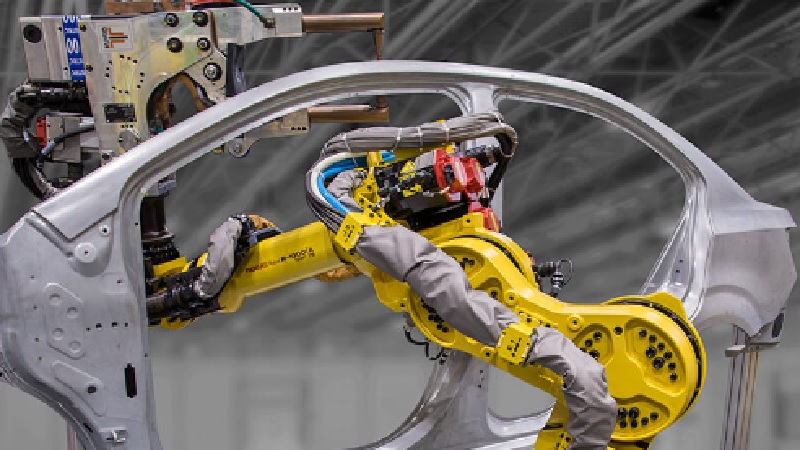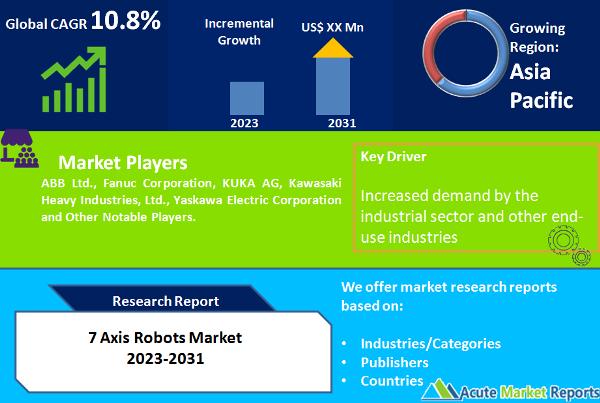
The 7-axis industrial robot market refers to the market for industrial robots that have seven axes of motion. These robots are capable of more complex movements and are often used in applications that require a high degree of precision and flexibility. The market for 7-axis industrial robots is expected to grow at a CAGR of 10.8% during the forecast period of 2025 to 2033. The market has been growing in recent years due to the increasing demand for automation in various industries such as automotive, electronics, and aerospace. The rise in demand for more advanced manufacturing processes and the need for increased efficiency in production have also contributed to the growth of this market. One of the key advantages of 7-axis robots is their ability to perform more complex tasks compared to robots with fewer axes. This increased range of motion allows for greater flexibility and accuracy in manufacturing processes, such as welding, painting, and material handling.

Increasing Demand for Automation
The demand for automation has been growing rapidly across industries as companies seek to increase efficiency, reduce costs, and improve the quality of their products. The global industrial automation market size is projected to grow to $270 billion by 2025, at a CAGR of 12% during the forecast period of 2025 to 2033. This growth is expected to drive the demand for more advanced robots, including 7-axis robots, that can perform complex tasks with precision and efficiency.
Increasing Applications of Advanced Technologies
The development of advanced technologies such as AI and ML has also played a key role in the growth of the 7-axis industrial robot market. These technologies have enabled robots to become more intelligent and adaptive, allowing them to perform a wider range of tasks and operate more efficiently. For example, AI-powered 7-axis robots can analyze data from sensors and adjust their movements to achieve greater accuracy and consistency in manufacturing processes.
Cost Remains as the Key Concern
One of the major restraints on the growth of the 7-axis industrial robot market is the high cost of these robots. 7-axis robots are typically more expensive than robots with fewer axes, which can make them less accessible to smaller companies or those with limited budgets. According to a report by Allied Market Research, the average cost of a 7-axis robot is around $70,000, which can be a significant investment for many companies.
Need for Skilled Resources to Challenge the Market Growth
One of the significant challenges in the 7-axis industrial robot market is the need for skilled personnel to operate and maintain these robots. As these robots become more complex and capable, it can be difficult for companies to find and train personnel with the necessary skills and expertise to operate and maintain them. This can create a bottleneck in adopting these robots, particularly for smaller companies with limited resources.
Double Arm Robots Dominate the Market by Type
In terms of revenue, double-arm robots have the highest market share. This is due to the high demand for these robots in the automotive and aerospace industries, where they are used for tasks such as welding, painting, and assembly. The double-arm robots market is expected to grow at a CAGR of 11.5% between 2025 and 2033. This growth is driven by the increasing adoption of automation technologies in the manufacturing industry, as well as the demand for higher precision and efficiency in manufacturing processes. Single-arm robots, on the other hand, have a smaller market share but are expected to grow at a higher CAGR of 15% between 2025 and 2033. This growth is driven by the increasing demand for these robots in the electronics and semiconductor industries, where they are used for tasks such as chip handling and wire bonding. Additionally, the increasing focus on collaborative robots, which can work alongside human workers, is expected to drive the growth of the single-arm robots market.
Automotive Industry Leads the Revenues While 3C Industry to Lead the Growth
The automotive industry has the highest revenue in the 7-axis industrial robot market due to the high demand for automation. The automotive industry accounted for the largest share of the 7-axis robot market in 2024, with a market share of 43%. The report also estimates that the automotive industry will continue to dominate the market in terms of revenue during the forecast period of 2025 to 2033. The 3C industry is expected to grow at the highest CAGR of 15% during the forecast period. These robots are used for tasks such as assembly, material handling, and pick-and-place operations in the production of electronic components. As industries continue to adopt automation technologies and advanced manufacturing processes, the demand for 7-axis industrial robots is expected to grow, providing opportunities for robot manufacturers and suppliers to expand their market presence and meet the evolving needs of manufacturers.
APAC Remains as the Global Leader
In 2024, Asia Pacific had the highest revenue with a revenue share of 45% in the 7-axis industrial robot market due to the significant demand for automation in various industries, such as automotive, electronics, and aerospace. The region is expected to continue its dominance in terms of revenue during the forecast period. APAC is driven by the increasing adoption of automation technologies in manufacturing processes and the growth of industries such as automotive and electronics. Europe and North America are also significant markets for 7-axis industrial robots, with a growing demand for automation in various industries. In Europe, countries such as Germany and France are major players in the 7-axis industrial robot market, driven by the high demand for robots in the automotive industry. In North America, the United States and Canada have a significant market share, driven by the increasing adoption of automation technologies in various industries.
Market Competition to Intensify During the Forecast Period
The 7-axis industrial robot market is highly competitive, with several players competing for market share. The key players in the market include ABB Ltd., Fanuc Corporation, KUKA AG, Kawasaki Heavy Industries, Ltd., and Yaskawa Electric Corporation, among others. To remain competitive, these players are adopting various strategies, including mergers and acquisitions, partnerships, and product launches. For instance, in 2020, ABB Ltd. acquired Codian Robotics, a Dutch company that develops delta robots for high-precision pick and place applications. The acquisition is expected to strengthen ABB's portfolio of robots for packaging and logistics applications. Similarly, in 2021, KUKA AG announced a strategic partnership with Huawei Technologies to develop smart manufacturing solutions for the industrial Internet of Things (IIoT) market. The partnership is expected to combine KUKA's expertise in robotics with Huawei's expertise in cloud computing and data management, to provide customers with comprehensive solutions for Industry 4.0. As the demand for advanced manufacturing technologies continues to grow globally, the competition in the 7-axis industrial robot market is expected to intensify, providing opportunities for innovation and growth for robot manufacturers and suppliers.
Historical & Forecast Period
This study report represents analysis of each segment from 2023 to 2033 considering 2024 as the base year. Compounded Annual Growth Rate (CAGR) for each of the respective segments estimated for the forecast period of 2025 to 2033.
The current report comprises of quantitative market estimations for each micro market for every geographical region and qualitative market analysis such as micro and macro environment analysis, market trends, competitive intelligence, segment analysis, porters five force model, top winning strategies, top investment markets, emerging trends and technological analysis, case studies, strategic conclusions and recommendations and other key market insights.
Research Methodology
The complete research study was conducted in three phases, namely: secondary research, primary research, and expert panel review. key data point that enables the estimation of 7 Axis Industrial Robots market are as follows:
Market forecast was performed through proprietary software that analyzes various qualitative and quantitative factors. Growth rate and CAGR were estimated through intensive secondary and primary research. Data triangulation across various data points provides accuracy across various analyzed market segments in the report. Application of both top down and bottom-up approach for validation of market estimation assures logical, methodical and mathematical consistency of the quantitative data.
| ATTRIBUTE | DETAILS |
|---|---|
| Research Period | 2023-2033 |
| Base Year | 2024 |
| Forecast Period | 2025-2033 |
| Historical Year | 2023 |
| Unit | USD Million |
| Segmentation | |
Type
| |
Application
| |
Design
| |
|
Region Segment (2023-2033; US$ Million)
|
Key questions answered in this report